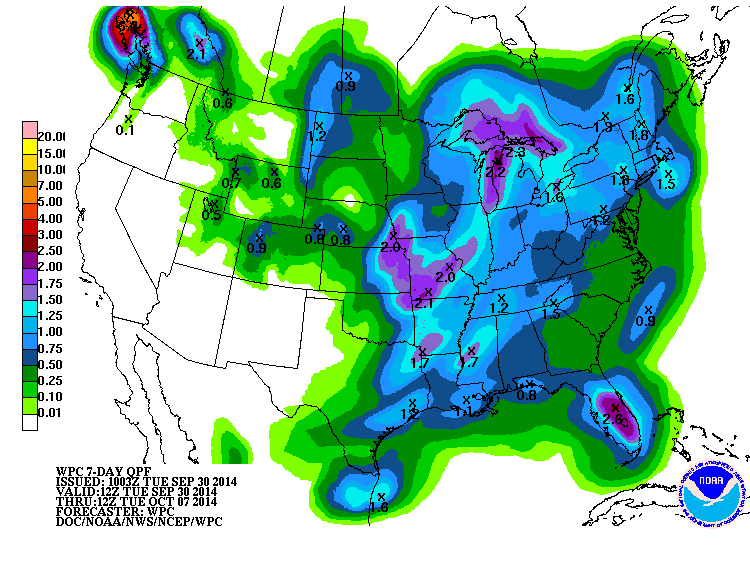Today (Tuesday and Wednesday) there is a risk of more severe weather across the central and southern plains.
Rainfall from the first system that ejected into the plains was very robust across northern Colorado, western Nebraska and into the northern plains. In the local area there was also generous rainfall across about half of the area. The map below shows the 24 hour precipitation that ended this Tuesday morning.
There will be a chance for additional rainfall through Thursday. The best chance for the high plains will be Wednesday night and Thursday as another developing upper system moves out of the Rockies. As of Tuesday afternoon this system (denoted by the red X on the map below) was moving into the Great Basin. The first storm (denoted by the red L) will drive a cold front into Kansas and then this front will interact or act as a focus for rainfall as the Great Basin system moves out. Rainfall will likely be heaviest across eastern Kansas but much of central High Plains should receive at least some rainfall by the end of the week.
This next map shows the possible precipitation amounts through early next Tuesday.
As the second Great Basin system moves out there will be some chilly air drop south behind it. I would not be surprised to see low temperatures fall into the mid or upper 30s as far south as Dodge City and Elkhart by Saturday morning. Freezing temperatures will be likely across the northern plains.
In the context of freezing temperatures, there has been a "killing" freeze across areas that normally see one by this time of year. BTW, a "killing" freeze is one where temperatures fall to at least 28 degrees for several hours. The following map shows where a killing freeze has already occurred.
...and this map shows the dates of the average first 28 degrees or colder of the fall...
For much of Kansas the first episode of 28 degrees or colder can vary considerably from year-to-year but the median date runs from October 11-20 across the northwest to November 1-10 across the south central and southeast. Remember, this is for a "killing" freeze and not frost or light freeze.
Looking ahead, I'm starting to see SOME indications of an active period from around October 11 - 17 and if this comes to pass I would bet there will be some pretty cold weather following in the wake of that period. Pretty cold? A killing freeze. This scenario is just a possibility since right now there is NO computer model even remotely hinting that this could occur. In addition to the cold, there SHOULD be an opportunity or two for more precipitation. There will also be a chance or two for rain during the second week of October.
As we get deeper into October the weather may become increasingly active but confidence at this point is rather low. I soon as I see a pattern start to evolve, I will put out the seasonal outlook. Early indications based on some forcing locations across the northern hemisphere is for at least "normal" precipitation for the fall and winter across much of the area. I'm tilting the odds in favor of a wetter verse dryer pattern. Temperatures may see some wild swings but the average into the winter should favor normal to below.
More later on the outlook - I've got to gather more data!
Remember this is not an official discussion - it's my thoughts only.






No comments:
Post a Comment